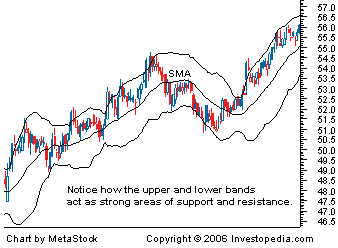Bollinger Band
A band plotted two standard deviations away from a simple moving average, developed by famous technical trader John Bollinger.

In this example of Bollinger bands, the price of the stock is banded by an upper and lower band along with a 21-day simple moving average.
Because standard deviation is a measure of volatility, Bollinger bands adjust themselves to the market conditions. When the markets become more volatile, the bands widen (move further away from the average), and during less volatile periods, the bands contract (move closer to the average). The tightening of the bands is often used by technical traders as an early indication that the volatility is about to increase sharply.
This is one of the most popular technical analysis techniques. The closer the prices move to the upper band, the more overbought the market, and the closer the prices move to the lower band, the more oversold the market.

In this example of Bollinger bands, the price of the stock is banded by an upper and lower band along with a 21-day simple moving average.
 | |
| Watch: Bollinger Bands |
Because standard deviation is a measure of volatility, Bollinger bands adjust themselves to the market conditions. When the markets become more volatile, the bands widen (move further away from the average), and during less volatile periods, the bands contract (move closer to the average). The tightening of the bands is often used by technical traders as an early indication that the volatility is about to increase sharply.
This is one of the most popular technical analysis techniques. The closer the prices move to the upper band, the more overbought the market, and the closer the prices move to the lower band, the more oversold the market.
附件列表
词条内容仅供参考,如果您需要解决具体问题
(尤其在法律、医学等领域),建议您咨询相关领域专业人士。
如果您认为本词条还有待完善,请 编辑
上一篇 Blow-Off Top 下一篇 Box Size
